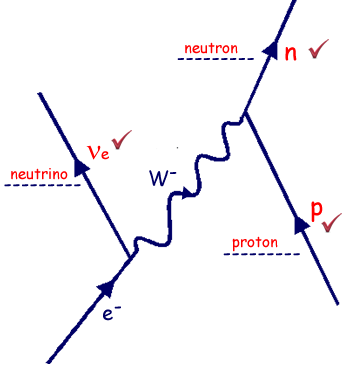Particle Questions that include Feynman Diagrams
Q5.
(a)
(i) Underline the particles in the following list that may be affected by the weak interaction:
positron |
neutron |
photon |
neutrino |
positive pion |

 if all correct - lose one mark for each error.
if all correct - lose one mark for each error.
(ii) Underline the particles in the following list that may be affected by the electromagnetic force.
electron |
antineutrino |
proton |
neutral pion |
negative muon |

 if all correct - lose one mark for each error..
if all correct - lose one mark for each error..
(4 marks)
(b) A positive muon may decay in the following way:

(i) Exchange each particle for its corresponding antiparticle and complete the equation to show how a negative muon may decay.

(ii) Give one difference and one similarity between a negative muon and an electron.
Difference: The electron has less mass (or rest energy) than the muon. 
Similarity: They are both fundamental particles - leptons OR they are both negative. 
(3 marks)
(c) Complete the Feynman diagram, which represents electron capture, by labelling all the particles involved.

(3 marks)
(Total 10 marks)


